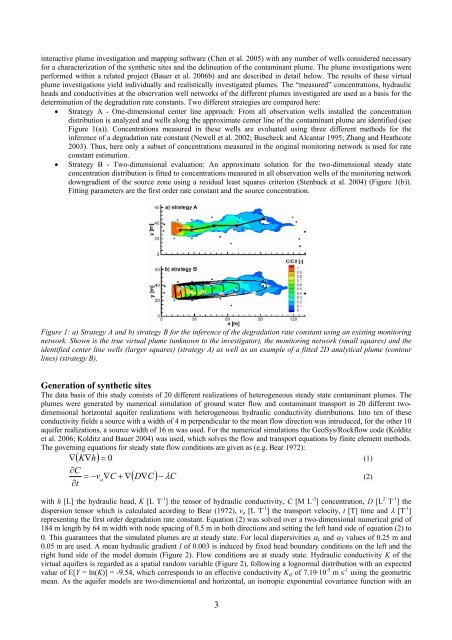Applied numerical modeling of saturated / unsaturated flow and ...
Applied numerical modeling of saturated / unsaturated flow and ...
Applied numerical modeling of saturated / unsaturated flow and ...
You also want an ePaper? Increase the reach of your titles
YUMPU automatically turns print PDFs into web optimized ePapers that Google loves.
interactive plume investigation <strong>and</strong> mapping s<strong>of</strong>tware (Chen et al. 2005) with any number <strong>of</strong> wells considered necessary<br />
for a characterization <strong>of</strong> the synthetic sites <strong>and</strong> the delineation <strong>of</strong> the contaminant plume. The plume investigations were<br />
performed within a related project (Bauer et al. 2006b) <strong>and</strong> are described in detail below. The results <strong>of</strong> these virtual<br />
plume investigations yield individually <strong>and</strong> realistically investigated plumes. The “measured” concentrations, hydraulic<br />
heads <strong>and</strong> conductivities at the observation well networks <strong>of</strong> the different plumes investigated are used as a basis for the<br />
determination <strong>of</strong> the degradation rate constants. Two different strategies are compared here:<br />
• Strategy A - One-dimensional center line approach: From all observation wells installed the concentration<br />
distribution is analyzed <strong>and</strong> wells along the approximate center line <strong>of</strong> the contaminant plume are identified (see<br />
Figure 1(a)). Concentrations measured in these wells are evaluated using three different methods for the<br />
inference <strong>of</strong> a degradation rate constant (Newell et al. 2002; Buscheck <strong>and</strong> Alcantar 1995; Zhang <strong>and</strong> Heathcote<br />
2003). Thus, here only a subset <strong>of</strong> concentrations measured in the original monitoring network is used for rate<br />
constant estimation.<br />
• Strategy B - Two-dimensional evaluation: An approximate solution for the two-dimensional steady state<br />
concentration distribution is fitted to concentrations measured in all observation wells <strong>of</strong> the monitoring network<br />
downgradient <strong>of</strong> the source zone using a residual least squares criterion (Stenback et al. 2004) (Figure 1(b)).<br />
Fitting parameters are the first order rate constant <strong>and</strong> the source concentration.<br />
Figure 1: a) Strategy A <strong>and</strong> b) strategy B for the inference <strong>of</strong> the degradation rate constant using an existing monitoring<br />
network. Shown is the true virtual plume (unknown to the investigator), the monitoring network (small squares) <strong>and</strong> the<br />
identified center line wells (larger squares) (strategy A) as well as an example <strong>of</strong> a fitted 2D analytical plume (contour<br />
lines) (strategy B).<br />
Generation <strong>of</strong> synthetic sites<br />
The data basis <strong>of</strong> this study consists <strong>of</strong> 20 different realizations <strong>of</strong> heterogeneous steady state contaminant plumes. The<br />
plumes were generated by <strong>numerical</strong> simulation <strong>of</strong> ground water <strong>flow</strong> <strong>and</strong> contaminant transport in 20 different twodimensional<br />
horizontal aquifer realizations with heterogeneous hydraulic conductivity distributions. Into ten <strong>of</strong> these<br />
conductivity fields a source with a width <strong>of</strong> 4 m perpendicular to the mean <strong>flow</strong> direction was introduced, for the other 10<br />
aquifer realizations, a source width <strong>of</strong> 16 m was used. For the <strong>numerical</strong> simulations the GeoSys/Rock<strong>flow</strong> code (Kolditz<br />
et al. 2006; Kolditz <strong>and</strong> Bauer 2004) was used, which solves the <strong>flow</strong> <strong>and</strong> transport equations by finite element methods.<br />
The governing equations for steady state <strong>flow</strong> conditions are given as (e.g. Bear 1972):<br />
∇( K ∇h)<br />
= 0<br />
(1)<br />
∂C<br />
= −va∇C<br />
+ ∇(<br />
D∇C)<br />
− λC<br />
(2)<br />
∂t<br />
with h [L] the hydraulic head, K [L T -1 ] the tensor <strong>of</strong> hydraulic conductivity, C [M L -3 ] concentration, D [L 2 T -1 ] the<br />
dispersion tensor which is calculated acording to Bear (1972), va [L T -1 ] the transport velocity, t [T] time <strong>and</strong> λ [T -1 ]<br />
representing the first order degradation rate constant. Equation (2) was solved over a two-dimensional <strong>numerical</strong> grid <strong>of</strong><br />
184 m length by 64 m width with node spacing <strong>of</strong> 0.5 m in both directions <strong>and</strong> setting the left h<strong>and</strong> side <strong>of</strong> equation (2) to<br />
0. This guarantees that the simulated plumes are at steady state. For local dispersivities αL <strong>and</strong> αT values <strong>of</strong> 0.25 m <strong>and</strong><br />
0.05 m are used. A mean hydraulic gradient I <strong>of</strong> 0.003 is induced by fixed head boundary conditions on the left <strong>and</strong> the<br />
right h<strong>and</strong> side <strong>of</strong> the model domain (Figure 2). Flow conditions are at steady state. Hydraulic conductivity K <strong>of</strong> the<br />
virtual aquifers is regarded as a spatial r<strong>and</strong>om variable (Figure 2), following a lognormal distribution with an expected<br />
value <strong>of</strong> E[Y = ln(K)] = -9.54, which corresponds to an effective conductivity Kef <strong>of</strong> 7.19·10 -5 m s -1 using the geometric<br />
mean. As the aquifer models are two-dimensional <strong>and</strong> horizontal, an isotropic exponential covariance function with an<br />
3

















